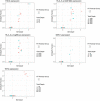Germline genetic biomarkers to stratify patients for personalized radiation treatment
- PMID: 35962345
- PMCID: PMC9373374
- DOI: 10.1186/s12967-022-03561-x
Germline genetic biomarkers to stratify patients for personalized radiation treatment
Abstract
Background: Precision medicine incorporating genetic profiling is becoming a standard of care in medical oncology. However, in the field of radiation oncology there is limited use of genetic profiling and the impact of germline genetic biomarkers on radiosensitivity, radioresistance, or patient outcomes after radiation therapy is poorly understood. In HNSCC, the toxicity associated with treatment can cause delays or early cessation which has been associated with worse outcomes. Identifying potential biomarkers which can help predict toxicity, as well as response to treatment, is of significant interest.
Methods: Patients with HNSCC who received RT and underwent next generation sequencing of somatic tumor samples, transcriptome RNA-seq with matched normal tissue samples were included. Patients were then grouped by propensity towards increased late vs. early toxicity (Group A) and those without (Group B), assessed by CTCAE v5.0. The groups were then analyzed for association of specific germline variants with toxicity and clinical outcomes.
Results: In this study we analyzed 37 patients for correlation between germline variants and toxicity. We observed that TSC2, HLA-A, TET2, GEN1, NCOR2 and other germline variants were significantly associated with long term toxicities. 34 HNSCC patients treated with curative intent were evaluated for clinical outcomes. Group A had significantly improved overall survival as well as improved rates of locoregional recurrence and metastatic disease. Specific variants associated with improved clinical outcomes included TSC2, FANCD2, and PPP1R15A, while the HLA-A and GEN1 variants were not correlated with survival or recurrence. A group of five HLA-DMA/HLA-DMB variants was only found in Group B and was associated with a higher risk of locoregional recurrence.
Conclusions: This study indicates that germline genetic biomarkers may have utility in predicting toxicity and outcomes after radiation therapy and deserve further investigation in precision radiation medicine approaches.
Keywords: GEN1; Germline variants; HLA-A; Head and neck squamous cell carcinoma; NCOR2; Predictive biomarkers of radiation toxicity; Radiogenomics; TET2; TSC2.
© 2022. The Author(s).
Conflict of interest statement
A.S. reports being a consultant/advisory board member for AstraZeneca, Varian Medical Systems, Primmune, and Jounce Therapeutics; reports receiving commercial research grants from Varian Medical Systems and Pfizer; holds ownership interest in Toragen Inc. outside of submitted work.
Figures



References
-
- Cancer ROT. Benefits and effectiveness. 2022. Updated October 10, 2020. https://www.targetingcancer.com.au/about-radiation-oncology/benefits-and.... Accessed May 24
-
- Lee J-H, Lee JCW, Leung W, et al. Polarization engineering of thermal radiation using metallic photonic crystals. Adv Mater. 2008;20(17):3244–3247. doi: 10.1002/adma.200703160. - DOI
Publication types
MeSH terms
Substances
Grants and funding
LinkOut - more resources
Full Text Sources
Medical
Research Materials
Miscellaneous

